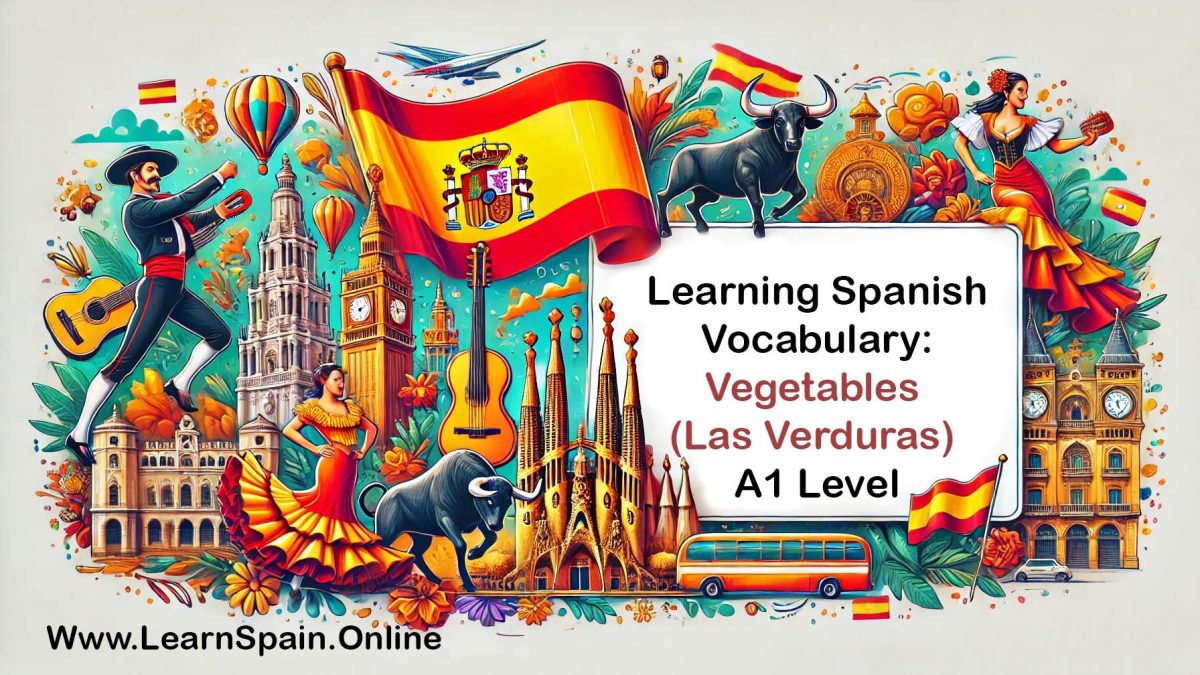
Story A1 A Day at the Park / Un Día en el Parque
August 31, 2024
Sentences and Short Stories for Learning Colors in Spanish (A1-A2 Level)
September 2, 2024Learning Spanish Vocabulary: Vegetables (Las Verduras) – A1 Level
Learning the names of vegetables in Spanish vocabulary is an essential part of building your vocabulary. Whether you’re grocery shopping, cooking, or simply talking about food, knowing how to refer to different vegetables in Spanish will be incredibly useful. This article will guide you through a comprehensive list of vegetables, providing examples of how to use them in sentences, as well as covering some key phrases and tips for learning. This post is tailored for beginners at the A1 level, with a focus on clear explanations and practical examples.
1. Common Vegetables (Verduras Comunes)
Let’s start with the most commonly used vegetables. These are the ones you’ll likely encounter frequently in everyday conversations and when shopping for groceries.
- La zanahoria – Carrot
- La papa / La patata – Potato
- El tomate – Tomato
- La cebolla – Onion
- El ajo – Garlic
- El pimiento – Bell pepper
- El pepino – Cucumber
- La lechuga – Lettuce
- El brócoli – Broccoli
- La espinaca – Spinach
- El apio – Celery
Examples:
- Las zanahorias son buenas para la vista.
(Carrots are good for your eyesight.) - Prefiero las papas fritas con mi hamburguesa.
(I prefer fries with my burger.) - El tomate es un ingrediente esencial en muchas salsas.
(Tomato is an essential ingredient in many sauces.) - La cebolla le da mucho sabor a la comida.
(Onion adds a lot of flavor to the food.)
2. Leafy Greens (Verduras de Hoja Verde)
Leafy greens are an important part of a healthy diet, and they are commonly found in salads, soups, and as side dishes.
- La lechuga – Lettuce
- La espinaca – Spinach
- La col rizada – Kale
- La acelga – Swiss chard
- El repollo / La col – Cabbage
Examples:
- La lechuga romana es ideal para ensaladas.
(Romaine lettuce is ideal for salads.) - La espinaca es rica en hierro.
(Spinach is rich in iron.) - Me gusta cocinar la col rizada con ajo.
(I like to cook kale with garlic.)
3. Root Vegetables (Verduras de Raíz)
Root vegetables grow underground and are often hearty, making them perfect for soups, stews, and roasts.
- La zanahoria – Carrot
- La papa / La patata – Potato
- La batata / El camote – Sweet potato
- El rábano – Radish
- La remolacha / El betabel – Beet
- El nabo – Turnip
Examples:
- Las papas al horno son un acompañamiento clásico.
(Baked potatoes are a classic side dish.) - Las batatas son una excelente fuente de vitamina A.
(Sweet potatoes are an excellent source of vitamin A.) - El rábano añade un toque picante a las ensaladas.
(Radish adds a spicy touch to salads.)
4. Squashes and Gourds (Calabazas y Calabacines)
These vegetables are versatile and can be used in everything from soups to desserts.
- La calabaza – Pumpkin
- El calabacín – Zucchini
- La calabaza butternut – Butternut squash
- La calabaza espagueti – Spaghetti squash
- El chayote – Chayote (a type of gourd common in Latin American cuisine)
Examples:
- La calabaza se usa mucho en postres y sopas.
(Pumpkin is used a lot in desserts and soups.) - El calabacín se puede asar, freír o hervir.
(Zucchini can be roasted, fried, or boiled.) - El chayote es popular en la cocina mexicana.
(Chayote is popular in Mexican cuisine.)
5. Peppers and Chilies (Pimientos y Chiles)
Peppers and chilies add flavor, color, and heat to dishes. They range from sweet to extremely spicy.
- El pimiento – Bell pepper
- El chile jalapeño – Jalapeño pepper
- El chile habanero – Habanero pepper
- El pimiento rojo – Red pepper
- El pimiento verde – Green pepper
Examples:
- El pimiento rojo es más dulce que el verde.
(Red pepper is sweeter than green pepper.) - Los chiles jalapeños son picantes pero deliciosos.
(Jalapeño peppers are spicy but delicious.) - El chile habanero es muy picante, úsalo con cuidado.
(Habanero pepper is very spicy, use it carefully.)
6. Legumes and Beans (Legumbres y Frijoles)
Legumes and beans are essential in many diets around the world, providing protein, fiber, and nutrients.
- El frijol – Bean
- El garbanzo – Chickpea
- La lenteja – Lentil
- El guisante – Pea
- La habichuela / El ejote – Green bean
Examples:
- Los frijoles negros son un alimento básico en la cocina latina.
(Black beans are a staple in Latin cuisine.) - Las lentejas son perfectas para hacer sopas nutritivas.
(Lentils are perfect for making nutritious soups.) - Los guisantes son dulces y deliciosos en ensaladas.
(Peas are sweet and delicious in salads.)
7. Herbs and Aromatics (Hierbas y Aromáticos)
Herbs and aromatic vegetables are used to flavor dishes and are essential in cooking.
- El ajo – Garlic
- La cebolla – Onion
- El perejil – Parsley
- El cilantro – Cilantro
- El orégano – Oregano
- El tomillo – Thyme
- El romero – Rosemary
Examples:
- El ajo es fundamental en muchas recetas.
(Garlic is fundamental in many recipes.) - El cilantro se usa mucho en la cocina mexicana.
(Cilantro is widely used in Mexican cuisine.) - El tomillo y el romero son perfectos para sazonar carnes.
(Thyme and rosemary are perfect for seasoning meats.)
8. Cruciferous Vegetables (Verduras Crucíferas)
These vegetables are known for their health benefits, particularly in supporting digestive health and providing antioxidants.
- El brócoli – Broccoli
- La coliflor – Cauliflower
- El repollo – Cabbage
- Las coles de Bruselas – Brussels sprouts
Examples:
- El brócoli es una excelente fuente de vitamina C.
(Broccoli is an excellent source of vitamin C.) - Las coles de Bruselas son deliciosas cuando se asan.
(Brussels sprouts are delicious when roasted.) - La coliflor se puede usar como sustituto del arroz.
(Cauliflower can be used as a rice substitute.)
9. Lesser-Known Vegetables (Verduras Menos Conocidas)
Here are some vegetables that might not be as familiar but are still important to know.
- El cardo – Cardoon
- La alcachofa – Artichoke
- El hinojo – Fennel
- El puerro – Leek
- La endibia – Endive
Examples:
- La alcachofa es deliciosa al vapor con un poco de limón.
(Artichoke is delicious steamed with a little lemon.) - El hinojo tiene un sabor similar al anís.
(Fennel has a flavor similar to anise.) - Los puerros son perfectos para hacer sopa de puerro y patata.
(Leeks are perfect for making leek and potato soup.)
Practical Exercises / Ejercicios Prácticos
Exercise 1: Match the Spanish Vegetable to Its English Name
- El pepino
- La cebolla
- El brócoli
- La lechuga
- El ajo
Answers:
- Cucumber
- Onion
- Broccoli
- Lettuce
- Garlic
Exercise 2: Translate the Sentences
- I like to add spinach to my smoothies.
- Me gusta añadir espinacas a mis batidos.
- The zucchini can be grilled or sautéed.
- **El calabacín se puede asar o saltear.**
- Garlic and onion are essential in cooking.
- El ajo y la cebolla son esenciales en la cocina.
- Brussels sprouts are healthy and delicious.
- Las coles de Bruselas son saludables y deliciosas.
- I always use fresh cilantro in my salsa.
- Siempre uso cilantro fresco en mi salsa.
Exercise 3: Create Sentences
Using the list of vegetables provided, create sentences in Spanish describing what you like or dislike about them.
Example:
- Me encanta el sabor del pimiento asado.
(I love the taste of roasted bell pepper.)
Conclusion
Knowing the names of vegetables in Spanish is an essential step in expanding your vocabulary, especially if you enjoy cooking or eating a healthy diet. With the list and examples provided, you should be well on your way to feeling comfortable discussing vegetables in Spanish. Remember to practice regularly, use these words in sentences, and soon you’ll be able to talk about food with confidence. ¡Buena suerte! (Good luck!)



1 Comment
[…] Learning Spanish Vocabulary: Vegetables (Las Verduras) – A1 Level […]